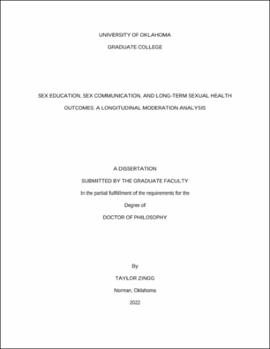| dc.contributor.advisor | Cheney, Marshall | |
| dc.contributor.author | Taylor, Zingg | |
| dc.date.accessioned | 2022-12-13T15:27:31Z | |
| dc.date.available | 2022-12-13T15:27:31Z | |
| dc.date.issued | 2022-12-16 | |
| dc.identifier.uri | https://hdl.handle.net/11244/336932 | |
| dc.description.abstract | Background: Unintended pregnancy and STIs are recognized by national organizations as a critical public health concern. A strategy to decrease risk of unintended pregnancy and STIs includes consistent use of condoms. School-based sex education is intended to inform and provide sexual risk reduction strategies targeted at young populations. Parents can also be a critical influence on adolescent risky sexual behaviors. This dissertation project explored longitudinal associations between school-based sex education and young adult unintended pregnancy, STI risk, and condom use behaviors. Additionally, this dissertation explored the moderating influence of parent-adolescent sex communication.
Methods: Measures of school-based pregnancy and HIV sex education reported by a nationally representative sample of adolescents were extracted from the National Longitudinal Study of Adolescent and Add Health’s (Add Health) Wave I In-Home survey. Waves II-V In-Home surveys provided outcome variables: the intention of first reported pregnancy, diagnosis of an STI, and condom use at recent sex. Two logistic regressions were employed using Stata 17 to explore longitudinal associations. Parent-adolescent sex communication variables from the Parent Interview were added to the models to explore the moderating effects between school-based sex education and young adulthood sexual health outcomes and behaviors.
Results: Study I: Of the 2,324 participants (53.6% female; 64.9% non-Hispanic White) that had school-based sex education, 46% reported their first pregnancy as intended, while 36.1% were unintended. Longitudinal results indicated that school-based sex education was not associated with long-term unintended pregnancy. Furthermore, parent-adolescent sex communication did not have a significant moderating influence on school-based sex education and unintended pregnancy. Study II: Of the 2,761 participants (47.3% female; 69.4% non-Hispanic White) that had school-based sex education, 15.3% were diagnosed with an STI between late adolescence to young adulthood. Longitudinal results indicated that school-based sex education was not associated with long-term STI risk. Parent-adolescent sex communication significantly interacted with participant biological sex, race, and parent educational attainment. Study III: Of the 1,899 participants (47.9% female; 69.4% non-Hispanic White) that had school-based sex education, 84.8% did not use a condom the last time they engaged in sexual intercourse. Longitudinal results indicated that school-based sex education was not associated with condom use at recent sex. Parent-adolescent sex communication significantly interacted with participant biological sex, race, and urbanicity.
Conclusion: School-based sex education may not influence long-term sexual risk behaviors. However, parent-adolescent sex communication can provide a foundation for positive sexual behaviors to be carried into young adulthood. Interventions focused on reducing adolescent sexual risk behavior should include parent participation. Parent-adolescent sex communication can be targeted in interventions to improve long term risk of unintended pregnancy, STI, and condom use.
Keywords: Unintended pregnancy, STI, condom use, school-based sex education, parent-adolescent sex communication | en_US |
| dc.language | en_US | en_US |
| dc.subject | Health Sciences, Education. | en_US |
| dc.subject | Health Sciences, General. | en_US |
| dc.subject | Education, Social Sciences. | en_US |
| dc.subject | Health Sciences, Public Health. | en_US |
| dc.title | Sex education, sex communication, and long-term sexual health outcomes: a longitudinal moderation analysis | en_US |
| dc.contributor.committeeMember | Lu, Yu | |
| dc.contributor.committeeMember | Larson, Rebecca | |
| dc.contributor.committeeMember | Mayeux, Lara | |
| dc.date.manuscript | 2022 | |
| dc.thesis.degree | Ph.D. | en_US |
| ou.group | Dodge Family College of Arts and Sciences::Department of Health and Exercise Science | en_US |
| shareok.nativefileaccess | restricted | en_US |
